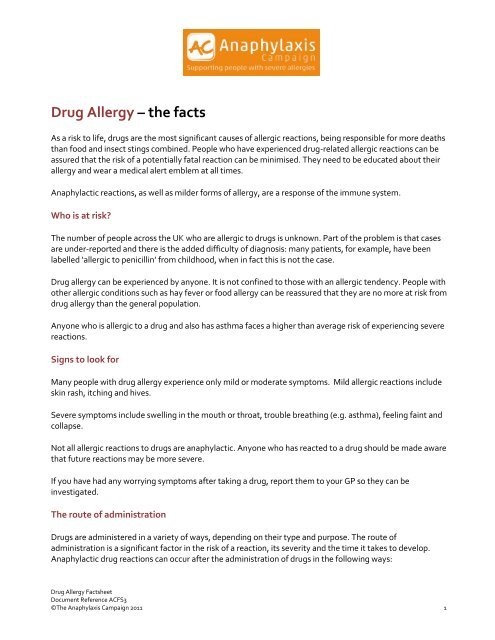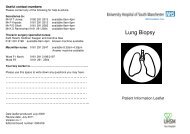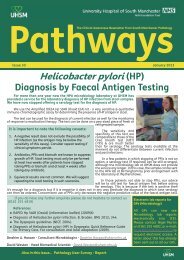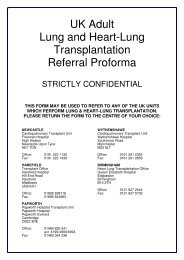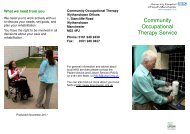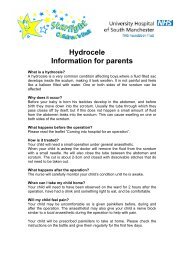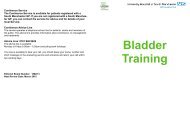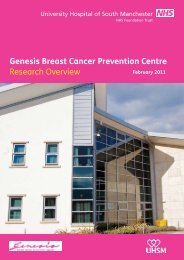Drug Allergy – the facts - Anaphylaxis Campaign
Drug Allergy – the facts - Anaphylaxis Campaign
Drug Allergy – the facts - Anaphylaxis Campaign
You also want an ePaper? Increase the reach of your titles
YUMPU automatically turns print PDFs into web optimized ePapers that Google loves.
<strong>Drug</strong> <strong>Allergy</strong> <strong>–</strong> <strong>the</strong> <strong>facts</strong><br />
As a risk to life, drugs are <strong>the</strong> most significant causes of allergic reactions, being responsible for more deaths<br />
than food and insect stings combined. People who have experienced drug-related allergic reactions can be<br />
assured that <strong>the</strong> risk of a potentially fatal reaction can be minimised. They need to be educated about <strong>the</strong>ir<br />
allergy and wear a medical alert emblem at all times.<br />
Anaphylactic reactions, as well as milder forms of allergy, are a response of <strong>the</strong> immune system.<br />
Who is at risk?<br />
The number of people across <strong>the</strong> UK who are allergic to drugs is unknown. Part of <strong>the</strong> problem is that cases<br />
are under-reported and <strong>the</strong>re is <strong>the</strong> added difficulty of diagnosis: many patients, for example, have been<br />
labelled ‘allergic to penicillin’ from childhood, when in fact this is not <strong>the</strong> case.<br />
<strong>Drug</strong> allergy can be experienced by anyone. It is not confined to those with an allergic tendency. People with<br />
o<strong>the</strong>r allergic conditions such as hay fever or food allergy can be reassured that <strong>the</strong>y are no more at risk from<br />
drug allergy than <strong>the</strong> general population.<br />
Anyone who is allergic to a drug and also has asthma faces a higher than average risk of experiencing severe<br />
reactions.<br />
Signs to look for<br />
Many people with drug allergy experience only mild or moderate symptoms. Mild allergic reactions include<br />
skin rash, itching and hives.<br />
Severe symptoms include swelling in <strong>the</strong> mouth or throat, trouble breathing (e.g. asthma), feeling faint and<br />
collapse.<br />
Not all allergic reactions to drugs are anaphylactic. Anyone who has reacted to a drug should be made aware<br />
that future reactions may be more severe.<br />
If you have had any worrying symptoms after taking a drug, report <strong>the</strong>m to your GP so <strong>the</strong>y can be<br />
investigated.<br />
The route of administration<br />
<strong>Drug</strong>s are administered in a variety of ways, depending on <strong>the</strong>ir type and purpose. The route of<br />
administration is a significant factor in <strong>the</strong> risk of a reaction, its severity and <strong>the</strong> time it takes to develop.<br />
Anaphylactic drug reactions can occur after <strong>the</strong> administration of drugs in <strong>the</strong> following ways:<br />
<strong>Drug</strong> <strong>Allergy</strong> Factsheet<br />
Document Reference ACFS3<br />
©The <strong>Anaphylaxis</strong> <strong>Campaign</strong> 2011 1
Injection: The most immediate and severe reactions are likely to follow injections, especially by <strong>the</strong><br />
intravenous route, in which <strong>the</strong> drug is introduced straight into <strong>the</strong> bloodstream and is rapidly distributed<br />
throughout <strong>the</strong> body.<br />
In patients allergic to <strong>the</strong> paralysing drugs given as part of a general anaes<strong>the</strong>tic, <strong>the</strong> onset of signs such as<br />
flushing, airway obstruction or drop in blood pressure may be apparent within seconds, and rarely take more<br />
than three minutes to start developing.<br />
In <strong>the</strong> case of injections beneath <strong>the</strong> skin (subcutaneous) or into a muscle (intramuscular), a local reaction in<br />
<strong>the</strong> form of reddening, swelling or weals, and itching may be apparent at <strong>the</strong> injection site at an early stage.<br />
Fortunately, its swift appearance, combined with <strong>the</strong> presence of medical or nursing staff (who give <strong>the</strong>se<br />
injections) means that <strong>the</strong>re should be prompt recognition and treatment before <strong>the</strong> reaction has time to<br />
progress.<br />
By mouth: Reactions to drugs taken by mouth may start within minutes, but may be delayed for up to two<br />
hours if <strong>the</strong> absorption of <strong>the</strong> drug is slow. In fact, some delayed-release drugs may cause reactions beginning<br />
many hours after administration.<br />
Application to <strong>the</strong> skin: antibiotics applied to burns may on rare occasions cause reactions.<br />
Vaccines<br />
<strong>Drug</strong>s given by injection, such as vaccines, are those most likely to trigger anaphylactic reactions. These<br />
include vaccines used for <strong>the</strong> prevention and treatment of infectious disease, or those for desensitising<br />
patients allergic to insect venom, pollen, cats, etc.<br />
An observation period of one hour is advisable for anyone having an injection who has suffered anaphylaxis in<br />
<strong>the</strong> past <strong>–</strong> whatever <strong>the</strong> cause. Signs of a severe reaction are likely to show <strong>the</strong>mselves quickly.<br />
It is advised that anyone having an anti-allergy vaccination should also be observed for one hour, extended if<br />
any signs of a generalised reaction become apparent.<br />
People who have had a severe reaction to egg should discuss <strong>the</strong> suitability of <strong>the</strong> seasonal flu or yellow fever<br />
vaccine with <strong>the</strong>ir treating doctor or allergy specialist. O<strong>the</strong>r vaccines whose components may have been<br />
prepared on egg medium, such as MMR, have been demonstrated to be safe, even in very egg-sensitive<br />
children.<br />
If <strong>the</strong>re is any concern whatsoever, that a patient may react to a vaccine, <strong>the</strong> vaccination can be given in<br />
hospital.<br />
Insulin<br />
Thousands of patients inject <strong>the</strong>mselves two or more times a day safely with insulin. Being a protein, insulin<br />
has <strong>the</strong> potential to produce allergic reactions. The fact that anaphylaxis to insulin injections is rare may be<br />
due to <strong>the</strong> fact that such injections, once started, are usually continued for life, and a degree of tolerance is<br />
<strong>Drug</strong> <strong>Allergy</strong> Factsheet<br />
Document Reference ACFS3<br />
©The <strong>Anaphylaxis</strong> <strong>Campaign</strong> 2011 2
thus induced. Insulin-induced anaphylaxis may be more common in patients whose treatment is interrupted<br />
or intermittent; this may apply more generally to o<strong>the</strong>r drugs too.<br />
Antibiotics<br />
These drugs, which include penicillin, are commonly used for treating infection. <strong>Allergy</strong> is sometimes blamed<br />
for symptoms <strong>the</strong>y are thought to cause, but this is not always <strong>the</strong> case.<br />
Infrequently, people allergic to one antibiotic may react to ano<strong>the</strong>r within <strong>the</strong> same ‘family’ of antibiotics (this<br />
is known as cross-reactivity). For this reason, a doctor should be consulted to discuss whe<strong>the</strong>r drugs in <strong>the</strong><br />
same family should be avoided.<br />
Diagnosis of penicillin allergy<br />
Penicillin allergy is a genuine problem, but <strong>the</strong> disease for which <strong>the</strong> penicillin has been administered may<br />
also cause allergy-like symptoms. This frequently leads to false diagnoses of penicillin allergy.<br />
For example, a delayed rash following ampicillin or amoxycillin in <strong>the</strong> context of a childhood illness is<br />
common and almost always does not suggest an underlying penicillin allergy. But if <strong>the</strong> rash is immediate, or<br />
if <strong>the</strong>re is nettle rash, or if <strong>the</strong>re are o<strong>the</strong>r symptoms such as facial swelling, itching or even anaphylaxis, <strong>the</strong><br />
doctor may decide testing is necessary. The person can be referred to an NHS allergy clinic, where skin prick<br />
testing (and occasionally intradermal skin testing) can be carried out, if appropriate; this is generally more<br />
helpful than blood tests.<br />
The label ‘allergic to penicillin’ should not be applied lightly. Many people, wrongly deemed ‘allergic to<br />
penicillin’ in childhood, are unnecessarily denied a safe and useful treatment, as doctors are reluctant to<br />
administer penicillin and related antibiotics to those who say <strong>the</strong>y are allergic.<br />
The best advice is to discuss any symptoms with your doctor. And if you are one of those people labelled<br />
‘allergic to penicillin’ since childhood, it is useful to try to find out why this label was applied. Medical records<br />
may hold <strong>the</strong> answer. It would be helpful to know which penicillin is thought to have caused <strong>the</strong> reaction.<br />
The o<strong>the</strong>r aspect to this problem is that <strong>the</strong> concept of penicillin allergy becomes devalued by its<br />
inappropriate use, so that patients genuinely in danger of a severe reaction may be given this antibiotic.<br />
Rashes after administration of antibiotics<br />
Rashes occur occasionally during <strong>the</strong> course of antibiotic treatment, but <strong>the</strong>se are not always signs of allergy<br />
to <strong>the</strong> antibiotic. The illness being treated (e.g. scarlatina) may be <strong>the</strong> cause of <strong>the</strong> rash. In o<strong>the</strong>rs, <strong>the</strong> disease<br />
in conjunction with <strong>the</strong> antibiotic, as with ampicillin and glandular fever, may cause <strong>the</strong> problem, <strong>the</strong><br />
antibiotic being well tolerated if taken again for some o<strong>the</strong>r reason.<br />
In assessing whe<strong>the</strong>r <strong>the</strong> symptoms are <strong>the</strong> result of genuine allergy, <strong>the</strong> nature and timing of <strong>the</strong> rash are<br />
important. The typical symptoms present during a genuine anaphylactic reaction to an antibiotic might be an<br />
urticarial rash (hives or nettle rash, with itchy weals), starting within a couple of hours of <strong>the</strong> first dose of a<br />
<strong>Drug</strong> <strong>Allergy</strong> Factsheet<br />
Document Reference ACFS3<br />
©The <strong>Anaphylaxis</strong> <strong>Campaign</strong> 2011 3
course. If symptoms begin quickly, this may also be a sign of a severe reaction. If <strong>the</strong> person has asthma, <strong>the</strong><br />
risk of severe symptoms is higher than for a non-asthmatic person.<br />
How likely am I to react to antibiotics?<br />
In <strong>the</strong> case of penicillin, <strong>the</strong> incidence of severe allergic reactions is less now than in <strong>the</strong> years immediately<br />
after <strong>the</strong> introduction of <strong>the</strong>se antibiotics. This may be because of improved methods of production and<br />
storage, since impurities or breakdown products caused some of <strong>the</strong> symptoms that patients experienced.<br />
Some people who reacted to penicillin in <strong>the</strong> past may be able to take it now.<br />
Analgesics<br />
This is a large group of drugs with pain-killing, fever-reducing and anti-inflammatory properties, known as <strong>the</strong><br />
‘aspirin-like drugs’ or as ‘non-steroid anti-inflammatory drugs’ (NSAIDs).<br />
Analgesics and anaphylactoid reactions<br />
Analgesics frequently induce reactions with features similar to those of anaphylaxis, such as breathing<br />
problems, urticaria (nettle rash) and angioedema (facial swelling), but <strong>the</strong> mechanism of <strong>the</strong>se reactions does<br />
not involve an immunological response. It is caused by a pharmacological side-effect of this group of drugs<br />
and strictly speaking, this is not allergy. Such reactions are known as ‘anaphylactoid’ or ‘pseudo-allergic’, to<br />
differentiate <strong>the</strong>m from <strong>the</strong> true anaphylactic reactions seen, for example, with vaccines or penicillins.<br />
Genuine allergic reactions to analgesics are rare.<br />
Testing for sensitivity to analgesics<br />
Anaphylactoid reactions are rarely life-threatening, and are more dose-related than true allergic reactions, in<br />
which minute doses of <strong>the</strong> drug can precipitate severe reactions. Because of this, challenge testing for<br />
sensitivity to analgesics (in which <strong>the</strong> patient ingests <strong>the</strong> drug under medical supervision) is a safer procedure<br />
than for antibiotic allergies. The substance is not likely to have a severe effect when administered in small<br />
quantities.<br />
Sensitivity to drugs in <strong>the</strong> same group<br />
Anyone who has had an anaphylactoid reaction to aspirin or ibuprofen should be considered sensitive to <strong>the</strong><br />
o<strong>the</strong>r drugs in this group until it is proved o<strong>the</strong>rwise. Paracetamol is <strong>the</strong> least likely drug in this group to cause<br />
reactions and <strong>the</strong> vast majority of aspirin-sensitive patients (about 95 per cent) will tolerate paracetamol.<br />
If a patient who has not had paracetamol for some time starts reacting to aspirin or ibuprofen, a supervised<br />
paracetamol challenge under medical supervision may be useful, to avoid <strong>the</strong>ir finding out that <strong>the</strong>y are in <strong>the</strong><br />
5 per cent, when <strong>the</strong>y are not under medical supervision.<br />
<strong>Drug</strong> <strong>Allergy</strong> Factsheet<br />
Document Reference ACFS3<br />
©The <strong>Anaphylaxis</strong> <strong>Campaign</strong> 2011 4
Since reactions are generally mild and dose-related, such challenges with paracetamol can safely be carried<br />
out in a primary care or outpatient department, unless <strong>the</strong> NSAID reaction has been particularly severe.<br />
Doses of 250, 500 and 1000 mg at two-hourly intervals would be appropriate for most such patients.<br />
For people who react to paracetamol, codeine-based painkillers are often well tolerated. Caution in reading<br />
labels and asking advice from a pharmacist are both essential. Bear in mind that aspirin is sometimes named<br />
only as acetylsalicylic acid.<br />
Anti-hypertensives<br />
Many different types of drug are used nowadays in <strong>the</strong> treatment of high blood pressure, some of which can<br />
cause anaphylactoid reactions, but true allergic sensitivity to such drugs is rare. In those with a predisposition<br />
to asthma, <strong>the</strong> beta-blockers are likely to precipitate bronchoconstriction, and should be avoided.<br />
ACE inhibitors, whose names generally end in ‘-pril’, can produce an anaphylactoid response such as a dry<br />
cough or angio-oedema, particularly if <strong>the</strong> swelling affects <strong>the</strong> lips, tongue and lower half of <strong>the</strong> face. Since<br />
<strong>the</strong> patient may tolerate <strong>the</strong> drug for months or even years before this problem arises and because it can be<br />
episodic, in spite of continuing treatment, it may not occur to <strong>the</strong> patient or <strong>the</strong>ir doctor that it is <strong>the</strong> ACE<br />
inhibitor that is to blame.<br />
As ACE inhibitors can cause severe life-threatening airway obstruction, an urgent review of <strong>the</strong> antihypertensive<br />
treatment regimen is required in any person who has experienced angio-oedema. ACE<br />
inhibitors should not be taken, for any cause, by anyone who has experienced angio-oedema, even if <strong>the</strong><br />
angio-oedema was triggered by something o<strong>the</strong>r than an ACE inhibitor.<br />
General anaes<strong>the</strong>sia<br />
<strong>Drug</strong>s used in general anaes<strong>the</strong>sia pose a particularly difficult problem, since <strong>the</strong> patient is generally asleep<br />
when <strong>the</strong> reactions start and recognition depends on <strong>the</strong> anaes<strong>the</strong>tist observing such symptoms as falling<br />
blood pressure, airway obstruction, etc., ra<strong>the</strong>r than symptoms reported by <strong>the</strong> patient. Fortunately,<br />
sensitivity to drugs used in general anaes<strong>the</strong>sia is rare, but because such drugs are injected directly into <strong>the</strong><br />
bloodstream, symptoms may be severe and rapid in onset and progression.<br />
Identifying <strong>the</strong> cause<br />
It is common for several drugs to be given toge<strong>the</strong>r, or in quick succession, at <strong>the</strong> induction of general<br />
anaes<strong>the</strong>sia; <strong>the</strong>se include induction agents (to render <strong>the</strong> patient unconscious), neuromuscular blockers (to<br />
paralyse <strong>the</strong> patient temporarily, to facilitate airway intubation and <strong>the</strong> surgical procedure), antibiotics,<br />
painkillers and blood or plasma substitute infusions. Any one of <strong>the</strong>se drugs may be implicated in<br />
anaphylactic or anaphylactoid reactions during anaes<strong>the</strong>sia. It is important to identify which agent was<br />
responsible and which alternatives are likely to be safe to use in future.<br />
Referral to a centre with experience of anaes<strong>the</strong>tic-related reactions is important and this should be <strong>the</strong><br />
responsibility of <strong>the</strong> anaes<strong>the</strong>tist who was present. Skin prick testing is a useful part of <strong>the</strong> investigative<br />
<strong>Drug</strong> <strong>Allergy</strong> Factsheet<br />
Document Reference ACFS3<br />
©The <strong>Anaphylaxis</strong> <strong>Campaign</strong> 2011 5
procedure. Provision of accurate details of <strong>the</strong> drugs administered, <strong>the</strong> timing and nature of <strong>the</strong> reaction<br />
observed, and any blood test results relevant to <strong>the</strong> case, are essential.<br />
In some cases <strong>the</strong> anaes<strong>the</strong>tic may not be responsible for <strong>the</strong> symptoms; for example <strong>the</strong> person may be<br />
having a reaction to <strong>the</strong> latex used in gloves or medical equipment.<br />
Local anaes<strong>the</strong>tics<br />
These are rare as causes of anaphylactic or anaphylactoid reactions. Sudden episodes of loss of<br />
consciousness, blood pressure drop or heart irregularity can occur during <strong>the</strong> induction of local anaes<strong>the</strong>sia<br />
for dental procedures and <strong>the</strong>se may point to an anaphylactic or anaphylactoid reaction. Subsequent<br />
investigation with skin testing followed by a challenge is usually negative, pointing to some o<strong>the</strong>r cause, such<br />
as a fainting reaction. It is important for patients not to be inappropriately labelled as ‘allergic’ to useful and<br />
safe drugs.<br />
In Summary<br />
With all drug allergies, but especially with those associated with <strong>the</strong> risk of an anaphylactic reaction, it is vital<br />
for <strong>the</strong> patient to be aware of exactly which drug was responsible and, if possible, which alternatives have<br />
been identified as safe. Information relating to drug allergies needs to be prominently recorded in primary<br />
care and hospital patient notes, but this is not a substitute for <strong>the</strong> patient <strong>the</strong>mselves being responsible for<br />
bringing such information to <strong>the</strong> attention of doctors, pharmacists or nurses, who may subsequently treat <strong>the</strong><br />
patient.<br />
It is important that anyone with drug allergy wears a medical alert bracelet or pendant, or carries a letter from<br />
a doctor explaining <strong>the</strong>ir allergy.<br />
The content of this Fact Sheet has been Peer Reviewed by Dr Lawrence Youlten, Medical Director, London<br />
<strong>Allergy</strong> Clinic and Visiting Consultant in <strong>Allergy</strong>, Addenbrooke's Hospital, Cambridge.<br />
Disclaimer <strong>–</strong> The information provided in this leaflet is given in good faith. Every effort has been taken to ensure accuracy. All<br />
patients are different, and specific cases need specific advice. There is no substitute for good medical advice provided by a<br />
medical professional.<br />
About <strong>the</strong> <strong>Anaphylaxis</strong> <strong>Campaign</strong> <strong>–</strong> ‘supporting people with severe allergies’<br />
The <strong>Anaphylaxis</strong> <strong>Campaign</strong> is <strong>the</strong> only UK wide charity to exclusively meet <strong>the</strong> needs of <strong>the</strong> growing numbers of<br />
people at risk from severe allergic reactions (anaphylaxis) by providing information and support relating to foods<br />
and o<strong>the</strong>r triggers such as latex, drugs and insect stings. Our focus is on medical <strong>facts</strong>, food labelling, risk<br />
reduction and allergen management. The <strong>Campaign</strong> offers tailored services for individual, clinical professional and<br />
corporate members. Visit our website www.anaphylaxis.org.uk.<br />
<strong>Drug</strong> <strong>Allergy</strong> Reviewed November 2011<br />
Document Reference ACFS3 Next review November 2014<br />
©The <strong>Anaphylaxis</strong> <strong>Campaign</strong> 2011<br />
The <strong>Anaphylaxis</strong> <strong>Campaign</strong>, PO Box 275, Farnborough, Hampshire GU14 6SX. Registered charity: 1085527<br />
Company Limited by guarantee. Company number: 4133242<br />
Telephone: 01252 546100 Helpline: 01252 542029<br />
info@anaphylaxis.org.uk www.anaphylaxis.org.uk<br />
6


